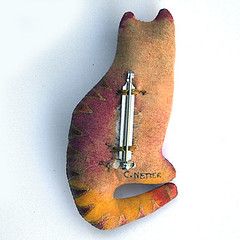How To Make a Hypertufa Pot
After letting the pot cure for about 24 hours, unwrap it and check it by poking a finger in it. It should not be at all squishy, but quite firm. You should be able to dent it with a finger nail, but not a finger. If you can push in a dent with just the finger, it won't hold it's shape when you unmold it. If it's still too soft, wrap it back up and leave it for a few more hours and check again. Make sure it's still moist and spray mist it if needed.
Once it's firm enough, carefully tip the pot out of the mold. Don't bang it or drop it since it's still quite fragile. The plastic lining should help it drop right out of the mold and you'll just have to peal the plastic off of it.
The holes might have closed up a bit or skimmed over. Open them up.
Now you can rough up the surface with a wire brush, or gently carve lines into the sides.
I rough up the entire surface because I like to make it look more rock like and hide some of the lines created by using the plastic trash bag. Also, it exposes the perlite and vermiculite for a more textured appearance. Be gentle since it's still quite fragile.
Once I've got it the way I want it, I put it back on the plastic.
I wet it down.
Then I wrap it up again to seal in the moisture.
Here it is, all wrapped up, ready to be moved to a shady location for a couple of weeks.
After a couple of weeks it should be pretty hard. I then finish the cure by unwrapping the pot and completely immersing it in water for another week or two. The water will need to be changed every few days. This will help leach out the lime in the surface of the pot so it won't hurt the plants. Once this is done, the pots are ready to plant.
Here are a bunch that just finished their final soak. Once they dry out, the color will be much lighter.
























0 comments:
Post a Comment